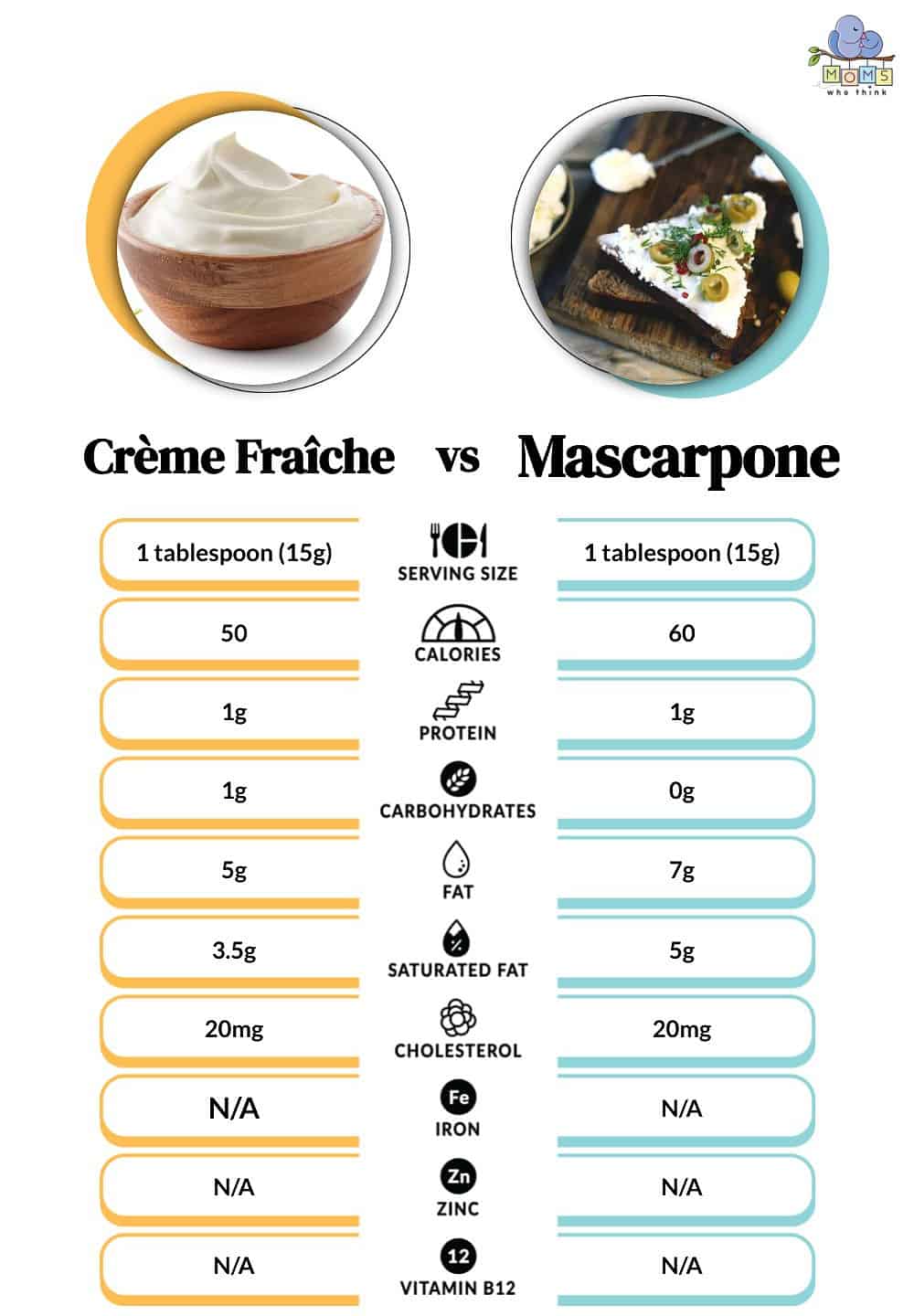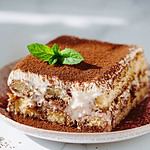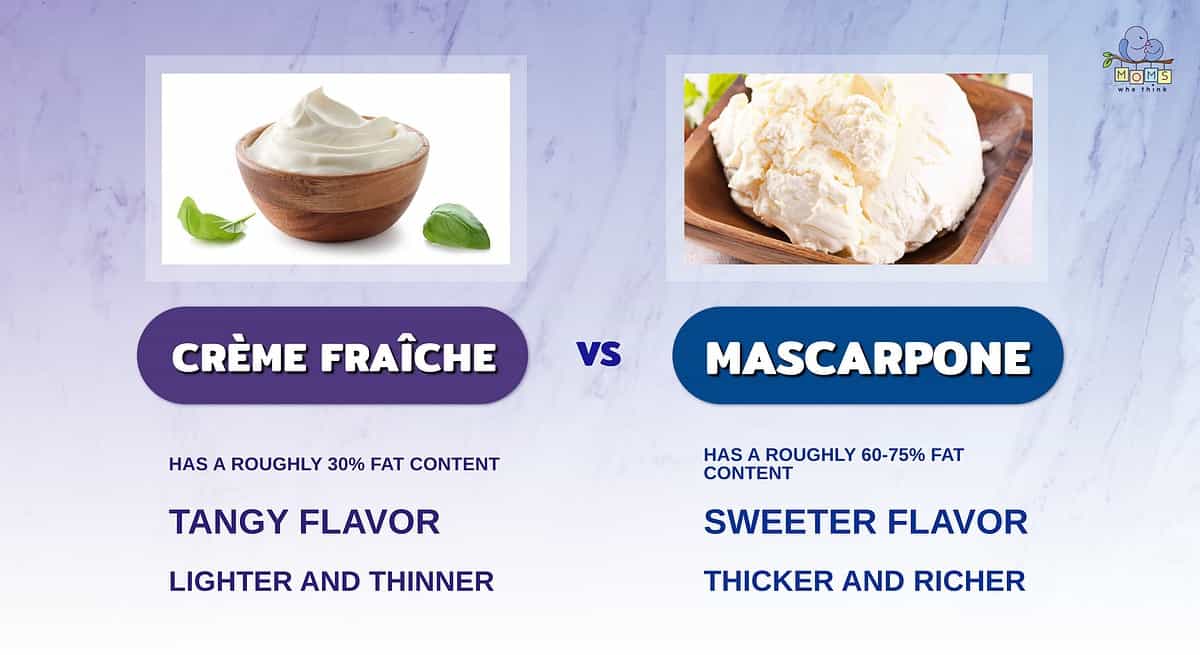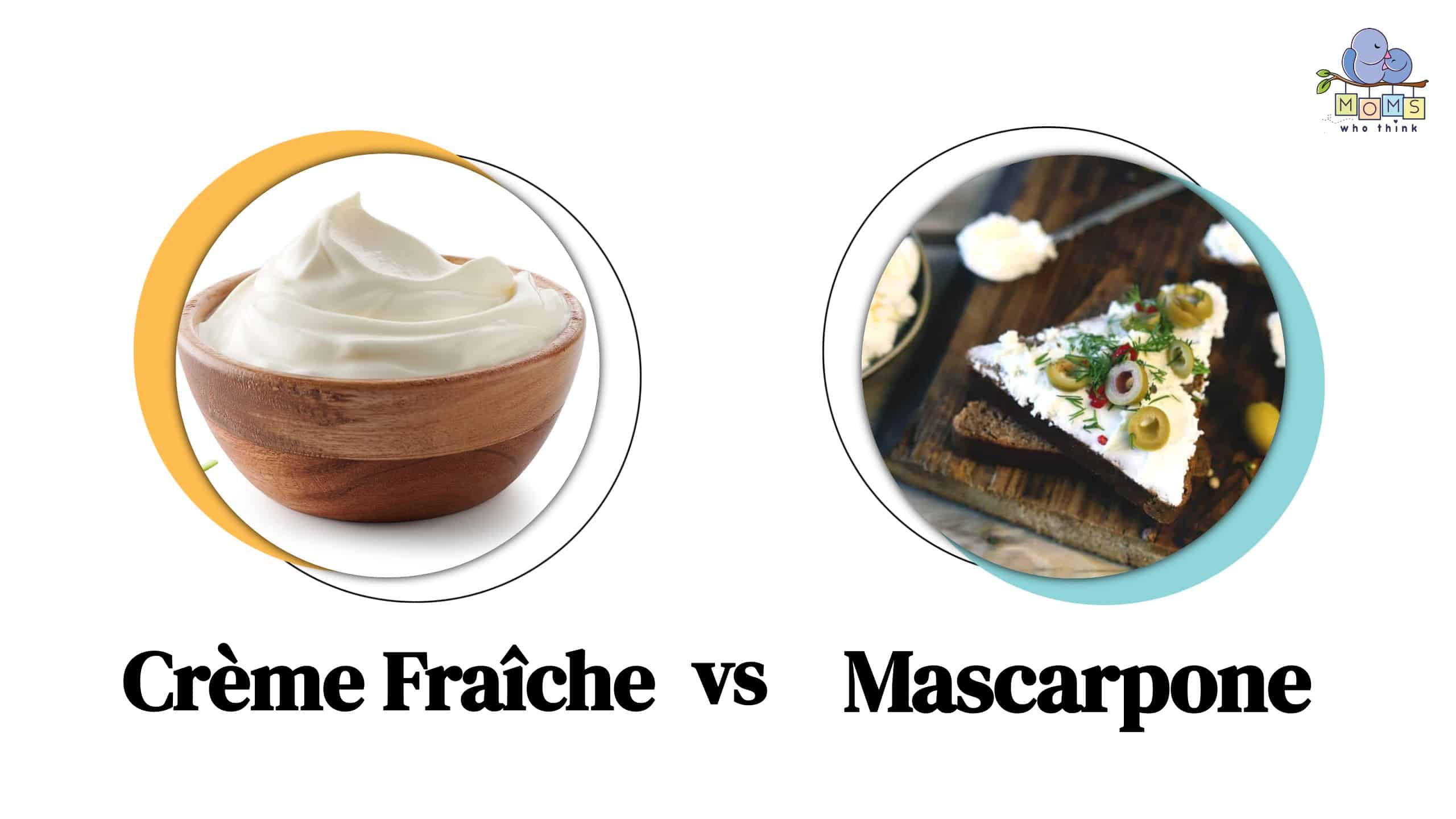Are you looking to take your family meals to the next level? Two ingredients that can elevate a dish are crème fraîche and mascarpone. These dairy products may seem similar, however, so it can be challenging to know which one to use and what sets them apart.
In this post, we'll take a deep dive into the world of crème fraîche and mascarpone, exploring their differences, unique flavors, textures, and uses in the kitchen. From savory sauces to sweet desserts, these two ingredients can make your next dish rich and flavorful.
Crème Fraîche vs. Mascarpone: What Is the Difference?
Both boast a rich, creamy texture. However, there are important differences between crème fraîche and mascarpone. Crème fraîche has a tangy flavor and 30% fat content, resulting in a lighter, thinner cream, while Mascarpone is sweeter, less acidic, and contains 60-75% fat, making it thicker and richer.
These differences make them suitable for distinct culinary applications, with crème fraîche being ideal for soups, sauces, and savory dishes, and mascarpone being perfect for desserts and sweet recipes. Finally, crème fraîche is of French origin while mascarpone is an Italian cream cheese.
Crème Fraîche vs. Mascarpone Nutrition: Calories, Fats, Protein

©
Generally, mascarpone has a higher fat content and calories when compared to crème fraîche. In the table above we've used the nutritional values for BelGioioso brand mascarpone, but other brands like Galbani will often have 120 calories and significantly higher fat content per serving.
What Is Crème Fraîche?

©Chatham172/Shutterstock.com
Crème fraîche (pronounced “krem fresh”) is a soured heavy cream and most closely resembles sour cream, though it's higher in fat content. This dairy product is a fresh (meaning it doesn't need to age) and versatile cream with a slightly tangy flavor.
Origin
Crème fraîche can be traced back to France and translates to “fresh cream.” While the first production of this ingredient is unknown, it's believed that crème fraîche was first made by farmers who let their unpasteurized cream sit at room temperature until it thickened and had a tangy flavor.
Today, crème fraîche is still a dairy staple in Europe, with less popularity in the United States.
Flavor
Because crème fraîche originates from heavy cream, it has a rich and creamy flavor. The addition of bacteria to this dairy product, however, gives it a slightly tangy taste. Crème fraîche can be described as a fresher, creamier, and tangier version of sour cream.
Texture and Appearance
While it looks similar to sour cream in its white color and creamy appearance, crème fraîche has a smooth texture and a higher fat content of around 30%. The higher fat comes from the rich cream that is used to produce it.
It's also important to note that the consistency may vary slightly depending on how this dairy product is produced. It can range from slightly runny to thick and creamy, similar to whipped cream without the fluffiness.
How Crème Fraîche Is Made
Crème fraîche is made by adding a bacterial culture to heavy cream. In France, this product is made with unpasteurized cream that already has healthy bacteria that thickens. In other places of the world, including the U.S., bacteria need to be added to the cream in order to start the thickening process.
Crème fraîche is also extremely easy to make at home and only requires only 2 ingredients: heavy cream and buttermilk.
Simply combine one tablespoon of buttermilk with one cup of heavy cream in a saucepan. Once it's warm, you can transfer the mixture to a glass bowl and cover it. Let it stand for 12 to 24 hours until it's thick and creamy. Then, place it in the refrigerator for 24 hours before adding it to your next dish.
Popular Uses
As mentioned, crème fraîche is extremely versatile and can be used in both sweet and savory dishes. One of the reasons it's so versatile is that it doesn't break down when heated. This means that the cream can be added to hot dishes like soups and sauces to thicken them. It can also be a great addition to stews and casseroles.
Additionally, crème fraîche is often used as a topping for fresh fruit or served alongside desserts like pie or cake. A dollop can also be added next to smoked salmon or on top of nachos or tacos.
What Is Mascarpone?

©Chatham172/Shutterstock.com
Similar to crème fraîche, mascarpone is a fresh cheese that doesn't require aging. However, mascarpone tends to be creamier and is often referred to as the Italian version of cream cheese, though it tends to be even richer and creamier than the cream cheese we typically see in the local grocery store.
Origin
Mascarpone is considered the Italian cream cheese because it originated in the Lombardy region of northern Italy. While the exact origins are unclear, the Britannica encyclopedia states that this cheese was likely first produced in the 16th century.
Today, mascarpone is still famously made in Italy. But it's also produced worldwide and can be found at most large grocery stores or specialty cheese shops.
Flavor
Mascarpone is known for its rich flavor and slightly sweet, tangy taste. Because it's made from heavy cream that comes from cow's milk, it also tends to have a milky flavor.
Texture and Appearance
Mascarpone cheese is known for its high-fat content, which can range from 60-75%. This can be nearly twice as much as cream cheese, but it's also what gives this ivory-colored sweet cheese its signature velvety texture. Mascarpone is also easy to spread and incredibly smooth.
How Mascarpone Cheese Is Made
Like crème fraîche, mascarpone has an incredibly easy creation process. It's simply made from heavy cream and an acid. Most commercial producers will use citric acid, but lemon juice can be used if you're making this cheese at home.
After the cream has been heated, acid is added to create curdles. The curdles are then drained from the leftover liquid, also known as the whey, and the resulting cheese is packaged and refrigerated. Because mascarpone is a fresh cheese, it can be eaten on the same day.
One major difference between crème fraîche and mascarpone is that crème fraîche is made from thickened heavy cream, while mascarpone is made from the curdles that arrive from an acid addition.
Popular Uses
Mascarpone is most traditionally used in Italian desserts like tiramisu, cannoli, and cheesecake. However, because of its versatile, creamy texture, mascarpone can also be used in savory dishes like risotto, pasta sauces, and spreads.
Can You Substitute Crème Fraîche for Mascarpone?
On their own, these two dairy products do not work well as direct substitutes. Crème fraîche is a cultured cream with a pourable consistency and tangy flavor. Mascarpone is a soft spreadable cheese with a rich, creamy texture, and slightly sweet flavor.
Additionally, crème fraîche is best used as a thickener in sauces and soups or as a topping for desserts and fruit. Mascarpone is typically used in desserts like tiramisu or in savory pasta dishes.
In a pinch, a touch of sugar and thickener (like cornstarch) can be added to crème fraîche to make it more closely resemble mascarpone. On the other hand, milk or cream can thin out mascarpone to make it work in place of crème fraîche. It's best to not directly interchange these two dairy products, though.
Best Substitutes for Crème Fraîche
The best substitute for store-bought crème fraîche is to make your own at home using heavy cream and buttermilk like the recipe above. However, if you're in a pinch and need a quick replacement, these products can be used in its place:
Sour Cream
Sour cream is the most popular substitute for crème fraîche. While less rich in fat and a little thinner in consistency, sour cream does has a similar tangy flavor and creamy texture to crème fraîche. Equal amounts of each cream can be substituted in recipes.
Greek yogurt
Greek yogurt is a healthy and lower-fat substitute for crème fraîche. It also has a similar tangy flavor and creamy texture. Keep in mind, however, that full-fat Greek yogurt is the best option when looking to use it in place of cream, as high-fat Greek yogurt will offer the most creamy texture.
Mexican Crema
Mexican crema offers a similar tangy taste that makes it a good replacement for crème fraîche. However, it can be thinner in consistency and slightly sweeter, so it's best to use it in small amounts, like a dollop on top of a recipe or drizzled over soup.
Best Substitutes for Mascarpone
If you find yourself without mascarpone, you can use one of these ingredients as a replacement:
Cream Cheese
Cream cheese has a similar creamy texture to mascarpone, which makes it a great replacement in recipes like cheesecake or frosting. Keep in mind, however, that cream cheese has a tangier flavor than mascarpone, so you may need to adjust the sweetness of the recipe accordingly.
Sour Cream
Sour cream is a great substitute for mascarpone in recipes that call for a tangy flavor and a smooth texture. It does tend to have a thinner consistency, however, so you may need to adjust your recipe to make up for this difference.
Whipped Cream
Whipped cream is a wonderful substitute for mascarpone in recipes like frosting or tiramisu that need a light and fluffy texture. It does tend to be sweeter than mascarpone, though, so the sweetness level of your recipe may need to be adjusted to accommodate.
Crème Fraîche Recipes
- Use crème fraîche instead of heavy cream in this sweet potato pudding recipe.
- Swap sour cream for crème fraîche in this cranberry orange overnight coffee cake.
- Add richness by replacing milk with crème fraîche in this creamy chicken spinach soup.
Mascarpone Recipes
Print
Classic Tiramisu Recipe
Description
Tiramisu is a decadent creamy dessert originating from Italy. In Italian, its name literally means, “pick me up”. That describes this tiramisu recipe perfectly, referring to its high-energy ingredients, strong coffee, and sugar. It has become a favorite in European and American restaurants. Since ladyfingers can be very difficult to find in the typical American grocery store, you can replace them with pound cake, biscotti, sponge cake, vanilla cookies, or angel food cake. To cut down on calories, you can also trade the mascarpone cheese for skim milk ricotta. Enjoy!
Ingredients
- 1/2 pound mascarpone cheese
- 3 egg yolks
- 1 package ladyfingers
- 4 tablespoons sugar
- 4 tablespoons brandy
- 1/4 cup whipping cream
- 1 cup strong espresso coffee, cooled
- 3 egg whites
- Cocoa powder
Instructions
- Beat cheese, egg yolks, 2 tablespoons of sugar, and 2 tablespoons of brandy.
- Beat egg whites until stiff and shiny. Whip cream.
- Gently fold the egg yolk mixture, egg whites, and cream together.
- Mix espresso with the remaining sugar and brandy.
- Dip ladyfingers in espresso mixture and line dish.
- Alternate layers of ladyfingers and cream; ending with cream.
- Dust with cocoa powder. Refrigerate.
- Serve at room temperature.
Final Thoughts

- The fat content in crème fraîche is vastly different from mascarpone. The former has a roughly 30% fat content, while the latter has a roughly 60-75% fat content.
- The flavor of crème fraîche is tangy, while mascarpone has a sweeter flavor to it.
- The extra fat content in mascarpone makes it thicker and richer than crème fraîche.
In conclusion, while crème fraîche and mascarpone are both rich and creamy dairy products, they differ widely in texture, flavor, and culinary use. While crème fraîche is a tangy cream and thinner in consistency, mascarpone is a fresh and rich cheese that more closely resembles cream cheese.
Now that you understand each of these ingredients in depth, you can take your family meals to the next level and create dishes that are rich, flavorful, and sure to impress.


